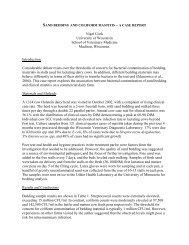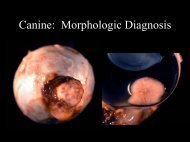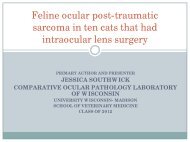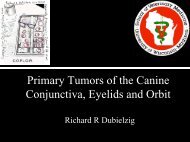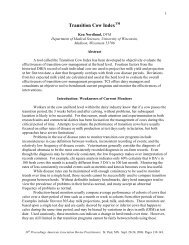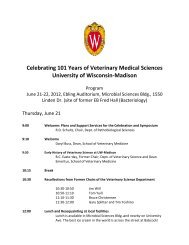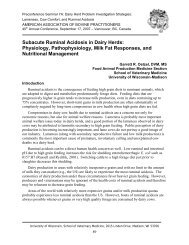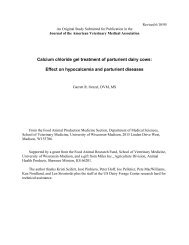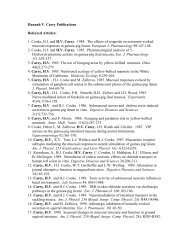Salmonellosis in Cattle: Is There Anything New - University of ...
Salmonellosis in Cattle: Is There Anything New - University of ...
Salmonellosis in Cattle: Is There Anything New - University of ...
You also want an ePaper? Increase the reach of your titles
YUMPU automatically turns print PDFs into web optimized ePapers that Google loves.
Preconvention Sem<strong>in</strong>ar 7: Dairy Herd Problem Investigation Strategies<br />
5. Implement a sound sanitation program based on clean<strong>in</strong>g all organic matter – feces, saliva, milk<br />
and blood – prior to use <strong>of</strong> dis<strong>in</strong>fectants (orthophenylphenol on surfaces and boots and chlorhexid<strong>in</strong>e<br />
for equipment).<br />
6. Look for development <strong>of</strong> newer vacc<strong>in</strong>es that target signal<strong>in</strong>g pathways and other unique strategies<br />
rather than rely<strong>in</strong>g on conventional bacter<strong>in</strong>s for prevention and control.<br />
7. A healthy <strong>in</strong>test<strong>in</strong>al environment gives cattle a competitive resistance. Survival <strong>of</strong> competitive<br />
lactobacilli <strong>of</strong>fer resistance to calves. Ma<strong>in</strong>ta<strong>in</strong> the normal gram negative flora (< 1% <strong>of</strong> the gi mass<br />
<strong>of</strong> bacteria and these are primarily anaerobes) by m<strong>in</strong>imiz<strong>in</strong>g oral antibiotic therapy.<br />
8. Maximize rumen function by consistent DMI <strong>in</strong> transition and parturient cows. VFA’s are toxic to<br />
salmonella.<br />
9. Recognize extended survival time <strong>of</strong> salmonellae <strong>in</strong> the environment and deal with potential for<br />
spread 4 to 5 years after outbreak.<br />
10. M<strong>in</strong>imize the chance for salmonellae to replicate by m<strong>in</strong>imiz<strong>in</strong>g time <strong>in</strong> moist, warm environmental<br />
conditions. Mix feeds <strong>in</strong> smaller batches and feed soon after mix<strong>in</strong>g. [Don’t feed the waste TMR to<br />
young stock].<br />
11. Warn farm families about zoonotic potential and assist them <strong>in</strong> implement<strong>in</strong>g the steps below to<br />
m<strong>in</strong>imize the risk.<br />
Avoid<strong>in</strong>g Zoonoses<br />
♦ Outer layer <strong>of</strong> protective cloth<strong>in</strong>g is left at farm or at the site <strong>of</strong> contam<strong>in</strong>ation<br />
♦ Gloves and protective wear<br />
♦ Hand wash<strong>in</strong>g<br />
♦ No eat<strong>in</strong>g or dr<strong>in</strong>k<strong>in</strong>g <strong>in</strong> work areas<br />
♦ Don’t dr<strong>in</strong>k raw milk<br />
<strong>University</strong> <strong>of</strong> Wiscons<strong>in</strong>, School <strong>of</strong> Veter<strong>in</strong>ary Medic<strong>in</strong>e, 2015 L<strong>in</strong>den Drive, Madison, WI 53706<br />
10



